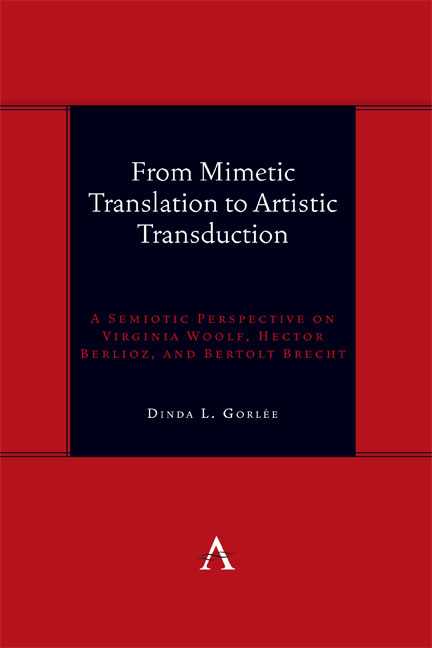 From Mimetic Translation to Artistic Transduction
From Mimetic Translation to Artistic Transduction Book contents
- Frontmatter
- Dedication
- Contents
- 1 Forked Tongues: Theory from Translation to Transduction
- 2 Wave after Wave: Wagner’s Waves Eclipsed by Virginia Woolf
- 3 War and Love: The Parabolic Retranslation in Berlioz’s Opera
- 4 The Threepenny Opera: Jakobson’s Poetics Retranslated in the Spirit of Brecht’s Work-Plays
- Bibliography
- Index
2 - Wave after Wave: Wagner’s Waves Eclipsed by Virginia Woolf
Published online by Cambridge University Press: 01 March 2024
- Frontmatter
- Dedication
- Contents
- 1 Forked Tongues: Theory from Translation to Transduction
- 2 Wave after Wave: Wagner’s Waves Eclipsed by Virginia Woolf
- 3 War and Love: The Parabolic Retranslation in Berlioz’s Opera
- 4 The Threepenny Opera: Jakobson’s Poetics Retranslated in the Spirit of Brecht’s Work-Plays
- Bibliography
- Index
Summary
Play Within Play
The double replacement of Wagner's linguistic-and-musical songs with the equivalent linguistic words of Woolf's novel is mingled together in Jakobson's interlingual translation and intralingual translation. Jakobson and Waugh (1979) paved the way for the pseudo-critical line of thought as lived through the sound shape of language. The transduction of vocal songs and their meaning can be defined as the retranslation of singable and performable words from old to new code languages (dialects, idioms or jargons), while the music remains unchanged and untranslated. Vocal or operatic translation seeks to transform lyrical works into the new setting of a different language. The double replacement of sound is made by a specialized translator working in the mixed area of literature and musicology, which also involves knowledge of theater studies. The hypertranslation made by the musical-and-literary translator becomes a co-authoring of the source translation brought to another language or pseudo-language, meaning that the translator's role is upgraded from that of secondary interpreter of the source text to that of a primary target interpreter.
Transduction works independently on the translational work through the translator co-interpreting the thematic, space-time and conceptual qualities of the source text. These revolutionary construction methods are inspired by the brain processes of the translator. The translator changes the elastic wave of conduction into the energy wave of transduction. The speed of the waves travels from the gravity surface of water into the higher graphical waves of the ellipsis, parabole and hyperbole (Shipley 1968/1972, 270–275). These waves are layered with the private “differences” in personal and cultural choice that make the “variations” and “invariations” of the source text, reshaping the target text away from the source text. The vocal translator is in the mixed position of doing more than intellectually retranslating the verbal text into another language without touching the musical values of the text. The operatic singers reinterpret and transpose the sounds into a different key—the perfect wave to perform the song or aria as a medium between artist and listeners.
- Type
- Chapter
- Information
- From Mimetic Translation to Artistic TransductionA Semiotic Perspective on Virginia Woolf, Hector Berlioz, and Bertolt Brecht, pp. 47 - 88Publisher: Anthem PressPrint publication year: 2023


